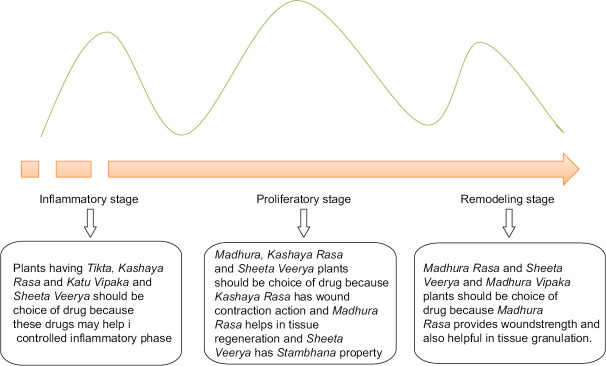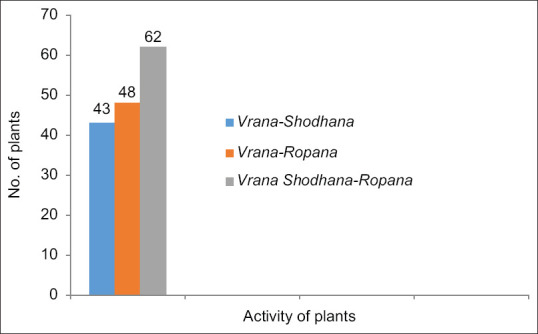Pharmacodynamic appraisal of wound-healing herbs of Sushruta Samhita.
引用次数: 0
Abstract
Background: In Sushruta Samhita, various medicinal plants as single and compound formulations having Vrana-Shodhana (wound cleansing) and Vrana-Ropana (wound healing) potential are enumerated. There are no published data available on these wound-healing medicinal plants of Sushruta Samhita. The effectivee management of wound is necessary in the immunocompromised and chronic wounds patients as they take more time to heal. Aim: To review and systematically analyze wound-healing medicinal plants and their modus-operandi on the basis of pharmacodynamics attributes, i.e., Rasa (taste), Veerya (potency), and Vipaka (biotransformation) in the various stages of healing. Materials and methods: Review of Sushruta Samhita was done to gather wound-healing medicinal plants; pharmacodynamics attributes were gatherd from various Nighantus to understand their role in wound healing. The contemporary information about wound-healing mechanism was gathered from PubMed to interpitate the rational use of plants in the various stages of wound healing. Results: The study suggests that 43 medicinal plants have Vrana-Shodhana activity, 48 have Vrana-Ropana and 62 have both Vrana-Shodhana and Vrana-Ropana potential. Medicinal plants with Vrana-Shodhana category are having predominance of Katu (pungent), Tikta (bitter) and Kashaya (astriengent) Rasa. Plants under Vrana-Ropana are having Madhura, Kashaya Rasa (sweet taste), Madhura Vipaka (sweet biotransform) and Sheeta Veerya (cold potency). Conclusion: Plants having Tikta, Kashaya Rasa, Katu Vipaka, and Sheeta Veerya may be useful in the inflammatory stage, plants having Madhura, Kashaya Rasa and Sheeta Veerya may be useful in the prolifiratory stage and plants having Madhura Rasa, Sheeta Veerya, and Madhura Vipaka may be useful in the remodeling stage. The present review will help to give the directions to the researchers for the development of effective wound-healing medicines for wounds.


苏hruta Samhita伤口愈合药材的药效学评价。
背景:在Sushruta Samhita中,列举了具有Vrana Shodhana(伤口清洁)和Vrana Ropana(伤口愈合)潜力的各种药用植物作为单一和复合制剂。目前还没有关于苏hruta Samhita的这些伤口愈合药用植物的公开数据。对于免疫功能低下和慢性伤口患者,有效的伤口管理是必要的,因为他们需要更多的时间来愈合。目的:根据药效学属性,即Rasa(味道)、Veerya(效力)和Vipaka(生物转化),回顾和系统分析创伤愈合药用植物及其在不同愈合阶段的作用方式。材料与方法:对山苏药材进行了综述,以收集创伤愈合药用植物;收集了各种Nighantus的药效学属性,以了解它们在伤口愈合中的作用。从PubMed收集了有关伤口愈合机制的当代信息,以促进植物在伤口愈合的各个阶段的合理使用。结果:研究表明,43种药用植物具有Vrana-Shodhana活性,48种具有Vrana Ropana活性,62种同时具有Vrana-Shodhana和Vrana-Ropana潜力。Vrana-Shodhana类药用植物以Katu(辛辣)、Tikta(苦涩)和Kashaya(收敛)Rasa为主。Vrana Ropana下的植物具有Madhura、Kashaya Rasa(甜味)、Madhura Vipaka(甜味生物转化)和Sheeta Veerya(冷效),Sheeta Veerya和Madhura Vipaka可能在重塑阶段有用。本综述将有助于为研究人员开发有效的伤口愈合药物提供指导。
本文章由计算机程序翻译,如有差异,请以英文原文为准。
求助全文
约1分钟内获得全文
求助全文

 求助内容:
求助内容: 应助结果提醒方式:
应助结果提醒方式:


